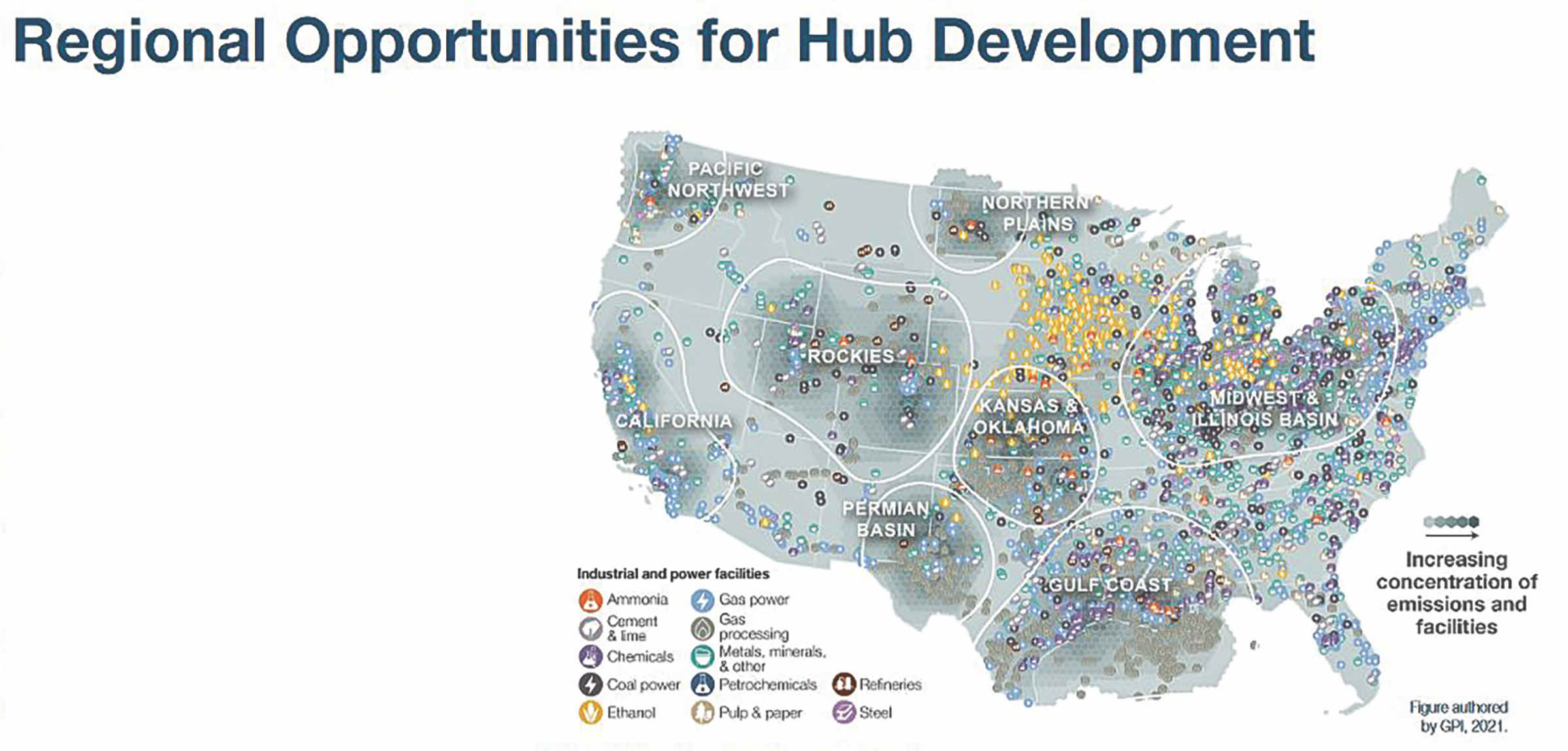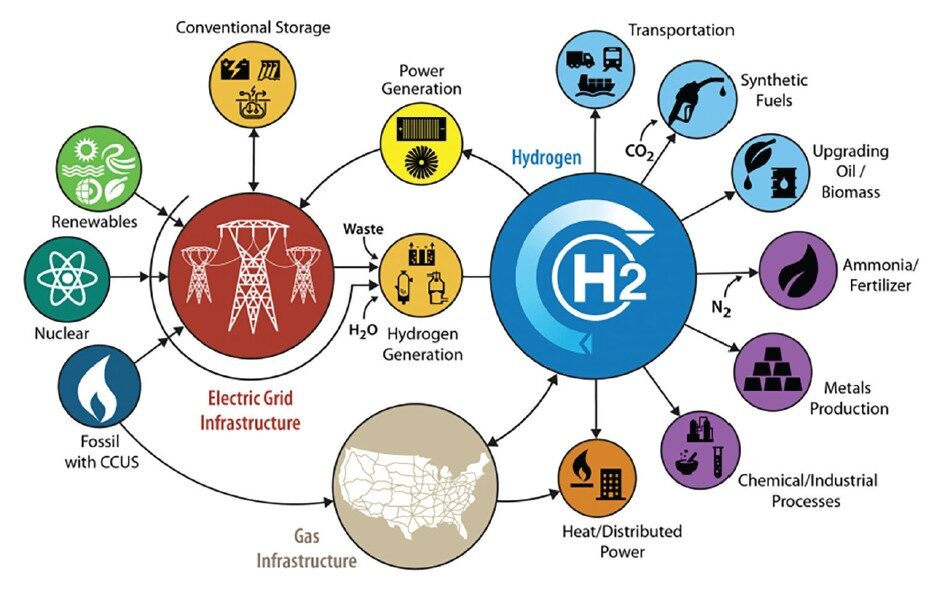Across the country, states are inking agreements with neighbors or striking out on their own to pursue billions in federal funding to set up “hydrogen hubs” (Figure 1),1 clustered centers for production, storage, and use of the gas that many see as a crucial piece of the puzzle for decarbonizing the U.S. economy.
How broad a role it should play, however, is a matter of debate.
The U.S. Department of Energy is looking to dole out $7 billion from last year’s bipartisan infrastructure law that could fund up to 10 regional clean hydrogen hubs (Figure 2),1 defined as “a network of clean hydrogen producers, potential clean hydrogen consumers and connective infrastructure located in close proximity” to be sited across the country.2

Figure 1. The Great Plains Institute created an atlas identifying eight regions where concentrated industrial activity coincides with opportunities for permanent geologic carbon storage.1 The identified regions emit a collective total of 1.7 billion metric tons of carbon dioxide emissions per year. On-site fuel combustion and process emissions account for 402 metric tons and 302 metric tons of carbon dioxide emissions, respectively. The Gulf Coast and Midwest and Illinois Basin regions currently lead in total stationary fuel consumption and in total emissions.Credit: Great Plains Institute

Figure 2. The Great Plains Institute identified 14 potential hubs across eight regions of the United States in its atlas. These suggestions are by no means exclusive, as industrial emissions occur throughout the country, and carbon removal or direct air capture will need to be deployed wherever beneficial. Credit: Great Plains Institute
“The H2Hubs will be a central driver in helping communities across the country benefit from clean energy investments, good-paying jobs and improved energy security—all while supporting President Biden’s goal of a net-zero carbon economy by 2050,” the department said in a news release in September 2022, calling the federal cash infusion one of the largest in the DOE’s history.3
That pool of money joins provisions in the Inflation Reduction Act—which created a clean hydrogen production tax credit4 and enacted big changes in carbon capture tax credits5—that could also boost hydrogen.
“Some states are going to be motivated by climate goals. Hydrogen is an important tool for achieving those climate goals,” says Bryan Willson, a professor of mechanical engineering and executive director of the Energy Institute at Colorado State University. “Others are really motivated by economic development and hydrogen represents a tremendous new business opportunity.”
Willson is also the director of the Rocky Mountain Alliance for Next Generation Energy,6 which is made up of universities and national labs from four western states that are providing technical support to the effort to create the Western Interstate Hydrogen Hub,7 a collaboration between Colorado, New Mexico, Utah, and Wyoming, two red states and two blue ones.
Matt Fry, a senior policy manager focusing on carbon management at the nonprofit Great Plains Institute8 and a former adviser to Republican Wyoming Gov. Matt Mead, says even conservative states have come around on the need to capture carbon and the obvious effects of a changing climate.
“We know that this is what we’re going to have to do,” he says. “We’ll utilize hydrogen as we bridge from a more fossil-fuel-based economy to a more electrified economy.”
Similar hub agreements have been made between Louisiana, Oklahoma, and Arkansas9; Minnesota, Montana, North Dakota, and Wisconsin10; and Connecticut, Massachusetts, New Jersey, and New York.11 Minnesota and Wisconsin also have a separate memorandum of understanding with Illinois, Indiana, Kentucky, Michigan, and Ohio aimed at “accelerating and improving” clean hydrogen production.12 And Oregon and Washington are also collaborating to create a Pacific Northwest hub.13
Other states, like Pennsylvania14 and Georgia,15 have launched efforts to create hubs on their own.
“The hubs are trying to focus on areas where you have resources to produce it, resources to use it and resources to balance that supply and demand,” says Jeffery Preece, director of research and development at the Electric Power Research Institute.
“We’re still working on where and how to deploy hydrogen in a decarbonized future. It’s important to bring stakeholders together … to figure this out. Getting it focused in hubs helps to really find those ways where we’re challenged with limitations on infrastructure today.”
Why hydrogen?
There is a consensus that hydrogen, which releases no carbon emissions when burned,16 could be a major part of addressing hard-to-decarbonize portions of the economy in which electrification is not feasible (Figure 3),17 including shipping;18 aviation;19 heavy ground transportation, such as rail;20 and industry, such as steelmaking21 and cement. Hydrogen fuel cells can power heavy vehicles such as long-haul tractor-trailers,22 which need greater range than batteries can currently provide, or hydrogen can be used to produce fuels compatible with existing internal combustion engines.23

Figure 3. Illustration showing how clean hydrogen could help decarbonize the U.S. economy.17 Credit: U.S. Department of Energy
It can also be blended—up to a certain point currently24—with natural gas to burn in gas turbines for electric generation. In what it called the largest test of its kind, Georgia Power reported in June that it was able to burn a 20% hydrogen blend in one of the turbines at its Plant McDonough-Atkinson natural gas power plant outside Atlanta, achieving a 7% reduction in CO2 emissions.25
“We are probably the most aggressive state in terms of decarbonization. Along with that we have increasing needs for storage and hydrogen basically gives the ability to fill in the gaps when the wind doesn’t blow and the sun doesn’t shine,” Willson of Colorado State University says.
But how clean hydrogen is depends on how it is produced. Right now, most hydrogen in the U.S. is produced using steam-methane reforming via natural gas,26 so-called “grey” hydrogen.27 “Green” hydrogen is produced by an electrolysis process with clean energy. “Blue” hydrogen is fossil-fuel derived but coupled with carbon capture,28 in which CO2 that would normally go up a smokestack or flue is filtered out of emissions and stored underground,29 though there are increasingly more efforts to find beneficial uses for that carbon.30
There is precious little green or blue hydrogen being produced at the moment, but Willson says the money for hydrogen hubs, production tax credits, and the Department of Energy’s Hydrogen Shot,31 an initiative to reduce the cost of hydrogen produced from renewable energy from the current cost of about $5 per kilogram to $1 per kilogram over the next decade, could change that.
“Right now there’s no question that hydrogen from fossil resources is cheaper,” he says. “But as the cost of renewables continues to drop and the cost of hydrogen continues to come down, the case for green hydrogen becomes pretty compelling.”
Given that dynamic, though, environmental groups worry that pushing to use hydrogen in scenarios in which renewable power and electrification (such as for home heating32 and appliances like stoves) make more sense could wind up prolonging the life of fossil fuels, particularly natural gas.
“In general when it comes to hydrogen we feel that there are some good opportunities there and there are also some very bad possibilities depending on how this is implemented,” says Patrick Drupp, the Sierra Club’s deputy legislative director for climate and clean air.
Drupp notes that the political wrangling over the infrastructure bill produced some constraints for the Department of Energy as it evaluates hydrogen hub proposals.
“Certain things were mandated in the legislation that we don’t agree with,” he says. “The DOE should focus on things where hydrogen has the best possible outcomes.”
For example, at least one hub must demonstrate the production of hydrogen from fossil fuels (with carbon capture), one must be from nuclear, and one must be from renewable energy. They must also be located in different regions of the U.S. “and shall use energy resources that are abundant in that region, including at least two H2Hubs in regions with abundant natural gas resources,” DOE documents state.33
Building out a large hydrogen economy, with its unique storage and transportation requirements, Drupp notes, will require expensive infrastructure such as new pipelines to handle high concentrations of hydrogen being blended into the natural gas system.
As of March 2022, natural gas and electric utilities had proposed more than two dozen pilot projects related to producing and distributing hydrogen for electric generation, heating buildings, or other uses, according to a report by Energy Innovation, Policy & Technology,34 a nonpartisan energy and climate policy think tank. Blending hydrogen with natural gas for those purposes would do little to curb greenhouse gas emissions and might “thwart more viable decarbonization pathways while increasing consumer costs, exacerbating air pollution and imposing safety risks,” the report warns.
“There’s a lot of money out there,” Drupp says. “The gas industry sees the writing on the wall and sees this as an opportunity to prolong their industry.”
This article is republished under Creative Commons license CC BY-NC-ND 4.0. It originally published Oct. 25, 2022, in the Ohio Capital Journal.
Cite this article
R. Zullo, “States are vying for money to start ‘hydrogen hubs’—what are they?,” Am. Ceram. Soc. Bull. 2023, 102(3): 36–39.
About the Author(s)
Robert Zullo is a national energy reporter based in southern Illinois focusing on renewable power and the electric grid. He joined States Newsroom in 2018 as the founding editor of the Virginia Mercury. Contact Zullo at rzullo@statesnewsroom.com.
Issue
Category
- Energy materials and systems
Article References
1“An atlas of carbon and hydrogen hubs for United States decarbonization,” Great Plains Institute, February 2022. https://scripts.betterenergy.org/CarbonCaptureReady/GPI_Carbon_and_Hydrogen_Hubs_Atlas.pdf
2“Regional Clean Hydrogen Hubs,” Department of Energy Office of Clean Energy Demonstrations. https://www.energy.gov/oced/regional-clean-hydrogen-hubs
3“Biden-Harris Administration announces historic $7 billion funding opportunity to jump-start America’s clean hydrogen economy,” Department of Energy, 22 Sept. 2022. https://www.energy.gov/articles/biden-harris-administration-announces-historic-7-billion-funding-opportunity-jump-start
4“Clean hydrogen and fuel cell incentives in the Inflation Reduction Act of 2022,” Baker Botts LLP, 22 Aug. 2022. https://www.bakerbotts.com/thought-leadership/publications/2022/august/clean-hydrogen-and-fuel-cell-incentives-in-the-inflation-reduction-act-of-2022
5Alejandro de la Garza, “The Inflation Reduction Act includes a bonanza for the carbon capture industry,” TIME, 11 Aug. 2022. https://time.com/6205570/inflation-reduction-act-carbon-capture
6Rocky Mountain Alliance for Next Generation Energy.
https://rangecollaborative.org/about-us
7“Memorandum of understanding: Western Inter-States Hydrogen Hub,” Energy Office of Colorado, 23 Feb. 2022.
https://energyoffice.colorado.gov/sites/energyoffice/files/documents/FINAL%20Western%20Inter-States%20Hydrogen%20Hub%20MOU.pdf
8Great Plains Institute. https://betterenergy.org/who-we-are
9“Louisiana, Oklahoma, and Arkansas announce hydrogen partnership,” Office of the Governor of Louisiana, 10 March 2022. https://gov.louisiana.gov/index.cfm/newsroom/detail/3587
10“Memorandum of understanding: Heartland Hydrogen Hub,” Office of the Governor of North Dakota, 5 Oct. 2022. https://www.governor.nd.gov/sites/www/files/documents/10.05.2022%20Heartland%20Hydrogen%20Hub%20MOU.pdf
11“New York leads consortium with other northeast states to develop a regional hydrogen hub proposal,” Coalition of Northeastern Governors. n.d. https://www.coneg.org/new-york-leads-consortium-with-other-northeast-states-to-develop-a-regional-hydrogen-hub-proposal
12“Midwestern Hydrogen Coalition (“M-H2 Coalition”) MOU,” Kentucky Governor Andy Beshear. n.d. https://governor.ky.gov/attachments/MidwesternHydrogenCoalitionMOU.pdf
13Alex Baumhardt, “Oregon, Washington hope to make Northwest the U.S. leader of ‘green hydrogen’ energy,” Oregon Capital Chronicle, 13 Sept. 2022.
https://oregoncapitalchronicle.com/2022/09/13/oregon-washington-hope-to-make-northwest-the-u-s-leader-of-green-hydrogen-energy
14“Bipartisan support continues for Gov Wolf clean hydrogen hub ambitions,” Office of the Governor of Pennsylvania, 3 June 2022. https://www.governor.pa.gov/newsroom/bipartisan-support-continues-for-gov-wolf-clean-hydrogen-hub-ambitions
15Thomas Wheatley, “Exclusive: Georgia coalition wants to compete for hydrogen hub,” Axios – Atlanta, 7 June 2022. https://www.axios.com/local/atlanta/2022/06/07/georgia-coalition-hydrogen-hub
16Steven Hamburg and Ilissa Ocko, “For hydrogen to be a climate solution, leaks must be tackled,” Environmental Defense Fund, n.d. https://www.edf.org/blog/2022/03/07/hydrogen-climate-solution-leaks-must-be-tackled
17“H2@Scale,” Department of Energy Hydrogen and Fuel Cell Technologies Office. https://www.energy.gov/eere/fuelcells/h2scale
18William Alan Reinsch and Will O’Neil, “Hydrogen: The key to decarbonizing the global shipping industry?” Center for Strategic and International Studies, 13 April 2021. https://www.csis.org/analysis/hydrogen-key-decarbonizing-global-shipping-industry
19“Hydrogen: An important pathway to our zero-emission ambition,” Airbus. https://www.airbus.com/en/innovation/zero-emission-journey/hydrogen
20Marybeth Luczak, “CP’s hydrogen locomotive powers up,” Railway Age, 25 Jan. 2022. https://www.railwayage.com/mechanical/locomotives/cps-hydrogen-locomotive-powers-up
21Mark Peplow, “Can industry decarbonize steelmaking?” C&EN, 13 June 2021. https://cen.acs.org/environment/green-chemistry/steel-hydrogen-low-co2-startups/99/i22
22“Heavy-duty vehicles an ideal entry into hydrogen fuel cell use,” Oak Ridge National Laboratory, 23 April 2021. https://www.ornl.gov/news/heavy-duty-vehicles-ideal-entry-hydrogen-fuel-cell-use
23“Power-to-X,” Ørsted. https://us.orsted.com/renewable-energy-solutions/power-to-x
24Daniel Esposito, “Gas utilities are promoting hydrogen, but it could be a dead end for consumers and the climate,” Forbes, 29 March 2022. https://www.forbes.com/sites/energyinnovation/2022/03/29/gas-utility-hydrogen-proposals-ignore-a-superior-decarbonization-pathway-electrification/?sh=204baaad76a1
25“Georgia Power, Mitsubishi Power, EPRI complete world’s largest hydrogen fuel blending at Plant McDonough-Atkinson,” Georgia Power, 10 June 2022. https://www.georgiapower.com/company/news-center/2022-articles/georgia-power-mitsubishi-power-epri-complete-worlds-largest-hydrogen-fuel-blending-at-plant-mcdonough-atkinson.html
26“Hydrogen production: Natural gas reforming,” Department of Energy Office of Energy Efficiency & Renewable Energy. https://www.energy.gov/eere/fuelcells/hydrogen-production-natural-gas-reforming
27“Hydrogen colours codes,” H2Bulletin. https://www.h2bulletin.com/knowledge/hydrogen-colours-codes
28“What is carbon capture and storage?” National Grid. https://www.nationalgrid.com/stories/energy-explained/what-is-ccs-how-does-it-work
29“Citronelle Project: Southeast Regional Carbon Sequestration Partnership,” National Energy Technology Laboratory. https://www.netl.doe.gov/sites/default/files/2018-11/Citronelle-SECARB-Project.PDF
30“Carbon conversion,” Department of Energy Office of Fossil Energy and Carbon Management. https://www.energy.gov/fecm/carbon-conversion
31“Hydrogen Shot,” Hydrogen and Fuel Cell Technologies Office. https://www.energy.gov/eere/fuelcells/hydrogen-shot
32“Heating our homes with hydrogen,” National Grid. https://www.nationalgrid.com/stories/energy-explained/heating-our-homes-hydrogen
33“Bipartisan Infrastructure Law: Additional clean hydrogen programs (Section 40314): Regional Clean Hydrogen Hubs funding opportunity announcement,” Department of Energy Office of Clean Energy Demonstrations. https://oced-exchange.energy.gov/Default.aspx#FoaId4dbbd966-7524-4830-b883-450933661811
34Sara Baldwin, Dan Esposito, and Hadley Tallackson, “Assessing the viability of hydrogen proposals: Considerations for state utility regulators and policymakers,” Energy Innovation Policy & Technology LLC. https://energyinnovation.org/wpcontent/uploads/2022/04/Assessing-the-Viability-of-Hydrogen-Proposals.pdf
Related Articles
Market Insights
Lessons learned from the rollout of 5G technology help guide 6G preparations
While it may seem like the 5G communications and data network has just been rolled out—and is, in fact, still in the process of being deployed—communications providers, governments, and researchers are already preparing for the sixth generation of wireless technology, or 6G. Compared to 5G, which aimed to expand the…
Bulletin Features
The synthetic data revolution: How AI is redefining quality control in ceramics manufacturing
The ceramics industry stands at the brink of a fundamental shift in how quality control is conceived, implemented, and scaled. For decades, the promise of artificial intelligence-powered inspection systems was held back by a persistent obstacle: the scarcity of high-quality data. This bottleneck made it difficult for ceramics manufacturers to…
Market Insights
Global edge AI market
The global market for edge artificial intelligence was valued at $8.7 billion in 2024 and is expected to grow at a compound annual growth rate (CAGR) of 36.9% to reach $56.8 billion by the end of 2030. Edge computing refers to data processing that occurs closer to where the data…





